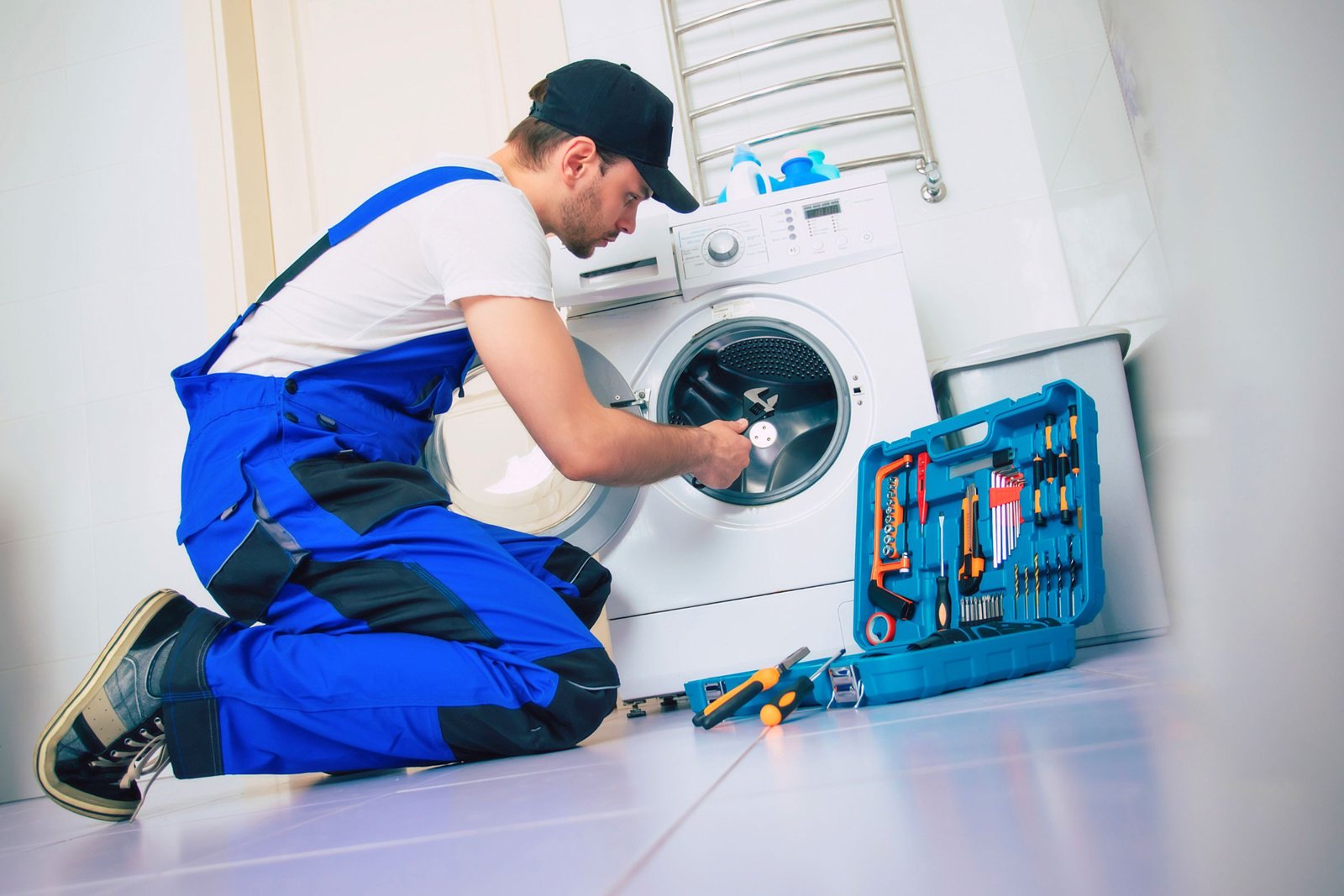In the heart of our homes, washing machines stand as silent champions, diligently tackling the chore of laundry. Yet, there are moments when these seemingly dependable appliances decide to go on strike, leaving us puzzled and our laundry hanging – literally. As we navigate the maze of modern conveniences, it becomes imperative to unravel the mysteries behind the unexpected pauses and disruptions in our washing routines.
This exploration delves into the common culprits that render washing machines temporarily incapacitated. From the seemingly innocent act of overloading to the intricate dance of sensors and the potential pitfalls of aging components, each aspect holds a clue to understanding and resolving these enigmatic strikes. Join us on this journey as we unveil the intricacies of washing machine mechanics, offering insights that not only troubleshoot the problems but also empower us to cultivate a harmonious relationship with our indispensable laundry companions. Let’s embark on a quest to decipher the language of washing machine strikes, transforming these interruptions into opportunities for informed care and efficient maintenance.
Overloading Woes: Unveiling the Risks of Pushing the Limits

Overloading your washing machine is a widespread but often overlooked issue that can significantly impact its performance. When you exceed the recommended capacity, several problems can arise, leading to a washing machine strike.
Mechanical Strain
Every washing machine has a specified load capacity designed to handle a certain amount of clothes per cycle. Overloading surpasses these limits, subjecting the machine’s mechanical components, such as the motor and bearings, to excessive stress. This strain can result in premature wear and tear, ultimately causing the machine to refuse operation.
Imbalanced Drum
An overloaded machine disrupts the balance of the drum during the wash and spin cycles. This imbalance not only affects the quality of cleaning but also triggers the washing machine’s automatic safety mechanisms. To prevent further damage, the machine may stop mid-cycle, signaling a strike.
Inadequate Detergent Distribution
Overloading inhibits proper detergent distribution across the clothes. This not only compromises the cleaning effectiveness but can also leave detergent residues on your clothes. The washing machine may sense this imbalance and halt its operation, awaiting correction.
Extended Cycle Times
Overloaded machines often struggle to complete cycles within the expected time frame. The extended duration of operation can overheat components and strain the motor, leading to an automatic shutdown to prevent overheating-related damage.
Preventing overloading is key to maintaining your washing machine’s health and longevity. Always adhere to the recommended load capacity, ensuring a smoother and more efficient laundry experience.
Unbalanced Loads: Maintaining Equilibrium for Optimal Washing

Achieving a well-balanced load in your washing machine is pivotal to its smooth operation. When clothes are unevenly distributed within the drum, it can lead to imbalances during cycles, causing the machine to go off-kilter and, in some cases, strike unexpectedly.
Causes of Imbalances
Unevenly placed items, like heavy towels on one side and lighter garments on the other, contribute to imbalances. This uneven weight distribution can create disruptions during the spinning phase, triggering the washing machine’s safety measures.
Effects on Spin Cycles
During the spin cycle, the drum rotates at high speeds to extract water from the clothes. An unbalanced load hinders this process, as the centrifugal force generated by the spinning motion is unevenly distributed. This can result in violent vibrations and a wobbly machine, prompting an automatic shutdown.
Tips for Achieving Balance:
To prevent unbalanced loads, follow these tips:
Mix Heavy and Light Items: Ensure a more balanced load by combining heavy and light items evenly. This prevents one side of the drum from becoming excessively weighted.
Arrange Clothes Evenly: Distribute clothes evenly around the drum to maintain equilibrium. Avoid placing all heavy items on one side and lighter items on the opposite side.
Use a Laundry Bag for Small Items: Small items, like socks or delicates, can accumulate in one section of the drum. Place them in a mesh laundry bag to distribute their weight evenly.
Automatic Corrections
Many modern washing machines are equipped with sensors that detect imbalances. When an irregularity is detected, the machine may attempt to redistribute the load or pause the cycle, signaling users to rearrange clothes for optimal balance.
By understanding and actively addressing the challenges posed by unbalanced loads, you can ensure your washing machine operates smoothly, minimizing the risk of unexpected strikes and disruptions in your laundry routine.
Wear and Tear: Navigating the Aging Process of Washing Machines

As washing machines gracefully age, the inevitable wear and tear on internal components become significant factors that can lead to malfunctions. Understanding how these components degrade over time and implementing regular maintenance practices is crucial for extending the lifespan of your appliance.
Common Components Affected
Several internal components are prone to wear and tear:
Bearings and Seals: Over time, the bearings and seals that support the drum’s rotation may wear out, resulting in increased friction and potential leaks.
Belts: The belts responsible for transferring power between the motor and the drum can weaken and stretch, affecting the machine’s overall performance.
Electrical Wiring: The wiring that controls various functions may undergo wear, leading to electrical issues and disruptions in the machine’s operation.
Symptoms of Wear and Tear
Recognizing signs of wear and tear can help you address potential problems before they escalate:
Unusual Noises: Grinding or squeaking noises during operation may indicate worn-out bearings, belts, or other moving parts.
Leakage: Deterioration of seals can result in water leaks, potentially damaging other components and the surrounding area.
Inconsistent Performance: A decline in overall washing performance, such as incomplete cycles or poor cleaning results, may be attributed to aging components.
Extending Lifespan Through Maintenance
Regular maintenance practices can significantly mitigate the impact of wear and tear:
Cleaning the Drum and Seals: Preventing the buildup of dirt and detergent residues can preserve the integrity of seals and minimize the risk of leaks.
Inspecting and Replacing Belts: Periodically checking and replacing worn-out belts ensures smooth and efficient power transfer.
Lubricating Moving Parts: Applying lubrication to bearings and other moving parts reduces friction, promoting optimal performance.
Professional Servicing
Consider scheduling periodic professional inspections and servicing to address wear and tear issues that may be beyond routine maintenance.
By proactively managing wear and tear, you can not only enhance the performance of your aging washing machine but also avoid unexpected malfunctions that could disrupt your laundry routine. Regular care becomes the cornerstone of ensuring your appliance stands the test of time.
Faulty Sensors: Navigating the Pitfalls of Modern Washing Machine Technology

In the era of smart appliances, modern washing machines boast advanced sensor technology designed to enhance efficiency and user experience. However, even these sophisticated sensors are not immune to glitches, and when they malfunction, they can be a source of unexpected strikes and disruptions in your laundry routine.
Types of Sensors
Modern washing machines are equipped with various sensors to monitor and regulate different aspects of the washing process:
Load Sensors: Determine the weight of the load to optimize water usage and adjust the washing cycle accordingly.
Water Level Sensors: Monitor the water level in the drum to prevent overfilling or inadequate water supply.
Temperature Sensors: Ensure the water temperature aligns with the selected wash cycle.
Imbalance Sensors: Detect uneven distribution of clothes to prevent excessive vibrations during spinning.
Malfunctions and Their Impact
When sensors fail to function correctly, they can cause a range of issues:
Incorrect Readings: Faulty load sensors may provide inaccurate weight measurements, affecting water usage and cycle duration.
Cycle Interruptions: Malfunctions in water level or temperature sensors can prompt the machine to pause mid-cycle, awaiting correction.
Imbalance Warnings: If imbalance sensors misread load distribution, the machine may incorrectly interpret it as an imbalance issue, leading to unnecessary interruptions.
Troubleshooting Sensor Issues
Addressing sensor malfunctions often requires a combination of user actions and professional assistance:
Check for Obstructions: Inspect sensor areas for any obstructions or debris that may interfere with their proper functioning.
Reset the Machine: Power off the machine, wait for a few minutes, and then restart it to reset sensor systems.
Professional Repairs: Persistent sensor issues may require the expertise of a professional technician to diagnose and replace faulty components.
Prevention Through Regular Maintenance
Regularly cleaning sensors and ensuring their unobstructed operation can prevent malfunctions. Additionally, following manufacturer-recommended maintenance practices can contribute to the longevity of sensor systems.
By understanding the role of sensors in your washing machine and being proactive in addressing malfunctions, you can minimize the risk of unexpected strikes and maintain the seamless performance of your technologically advanced appliance.
Water Supply Issues: Unraveling the Dilemma of Interrupted Washing

A reliable water supply is fundamental to the smooth operation of washing machines, but issues related to water availability or faulty water inlet valves can throw a wrench into your laundry routine, causing unexpected pauses and disruptions.
Inadequate Water Supply
Insufficient water reaching the washing machine can lead to multiple complications:
Incomplete Filling: The machine may struggle to fill the drum adequately, affecting the washing cycle’s efficiency.
Cycle Interruptions: Inadequate water levels trigger safety mechanisms, causing the machine to pause until the issue is resolved.
Poor Cleaning Results: A shortage of water compromises the detergent’s effectiveness, resulting in subpar cleaning outcomes.
Faulty Water Inlet Valves
Water inlet valves control the flow of water into the machine, and when they malfunction, it can spell trouble:
Leaks or Drips: Worn-out valves may lead to leaks, causing water to escape and potentially damage the surrounding area.
Overfilling or Underfilling: Malfunctioning valves might allow too much or too little water into the drum, disrupting the washing process.
No Water Flow: Complete failure of the water inlet valve can result in a total absence of water, prompting the machine to halt its operation.
Troubleshooting Water Supply Issues
Addressing water supply problems often involves a combination of user actions and professional assistance:
Check Water Supply: Ensure an adequate and consistent water supply to the washing machine. Confirm that water faucets are fully open and not obstructed.
Inspect Inlet Valves: Examine the water inlet valves for any visible damage, leaks, or signs of wear. Replace faulty valves promptly.
Clean Filters: Regularly clean inlet valve filters to prevent clogs that can impede water flow.
Preventive Measures
To minimize the risk of water supply issues, consider the following preventive measures:
Regular Maintenance: Follow manufacturer-recommended maintenance schedules to keep the machine and water inlet valves in optimal condition.
Use Quality Hoses: Ensure that water hoses connecting the machine to the water supply are in good condition and replace them if signs of wear are evident.
By addressing water supply issues promptly and adopting preventive measures, you can ensure a consistent and uninterrupted washing experience, minimizing the chances of unexpected pauses in your laundry routine.
Conclusion: Navigating Washing Machine Woes with Insight
In the intricate world of washing machines, understanding the reasons behind unexpected strikes empowers us to take charge of our laundry experience. From the pitfalls of overloading and unbalanced loads to the challenges posed by wear and tear, faulty sensors, and water supply issues, each obstacle provides an opportunity for informed intervention.
Regular maintenance emerges as a common thread throughout these challenges, offering a proactive approach to preserving the health and efficiency of our appliances. Whether it’s redistributing loads for balance, conducting routine check-ups on sensor functionality, or ensuring a steady water supply, investing time in preventive measures can significantly reduce the likelihood of disruptions during our laundry routines.
As we unravel the mysteries behind washing machine strikes, let’s not merely see them as inconveniences but as signals prompting us to care for and understand our trusted appliances better. By doing so, we not only extend the lifespan of our washing machines but also cultivate a seamless and stress-free laundry experience. In this journey, knowledge becomes the key to conquering washing machine woes and embracing the efficiency and longevity these appliances can offer.








